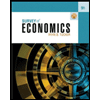↓ In Example 2.8, we discussed the recent increase in world demand for copper, due in part to China's rising consumption. Recall that the demand equation is Q = 27-3P, the supply equation is Q=-9+9P, the initial equilibrium price is P* $3.00 (dollars per pound), and the initial equilibrium quantity is Q* = 18 (million metric tons per year). 1. Using the given demand and supply equations, calculate the effect of a 35-percent increase in copper demand on the lit price of copper. Note: use the initial equilibrium values for P* (= $3.00) and Q* (= 18 million metric tons) when calculating the changes below. As a result of this change in demand, the price of copper will decimal places.) and the equilibrium quantity will by by $(Enter your response rounded to two million metric tons per year. (Enter your response rounded to two decimal places.) 2. Now suppose as weil that the U.S. production of copper declined between 2000 and 2003. Calculate the effect of both a 35-percent increase in copper demand (as you did above) and a 40-percent decline in copper supply. As a result of both of these changes, the equilibrium price of copper will rounded to two decimal places.) and the equilibrium quantity of copper will year. (Enter your response rounded to two decimal places.) by $ (Enter your response by million metric tons per SV
↓ In Example 2.8, we discussed the recent increase in world demand for copper, due in part to China's rising consumption. Recall that the demand equation is Q = 27-3P, the supply equation is Q=-9+9P, the initial equilibrium price is P* $3.00 (dollars per pound), and the initial equilibrium quantity is Q* = 18 (million metric tons per year). 1. Using the given demand and supply equations, calculate the effect of a 35-percent increase in copper demand on the lit price of copper. Note: use the initial equilibrium values for P* (= $3.00) and Q* (= 18 million metric tons) when calculating the changes below. As a result of this change in demand, the price of copper will decimal places.) and the equilibrium quantity will by by $(Enter your response rounded to two million metric tons per year. (Enter your response rounded to two decimal places.) 2. Now suppose as weil that the U.S. production of copper declined between 2000 and 2003. Calculate the effect of both a 35-percent increase in copper demand (as you did above) and a 40-percent decline in copper supply. As a result of both of these changes, the equilibrium price of copper will rounded to two decimal places.) and the equilibrium quantity of copper will year. (Enter your response rounded to two decimal places.) by $ (Enter your response by million metric tons per SV
Chapter4: Demand, Supply, And Market Equilibrium
Section: Chapter Questions
Problem 25P
Related questions
Question
help please answer in text form with proper workings and explanation for each and every part and steps with concept and introduction no AI no copy paste remember answer must be in proper format with all working!

Transcribed Image Text:↓
In Example 2.8, we discussed the recent increase in world demand for copper, due in part to China's rising consumption.
Recall that the demand equation is Q = 27-3P, the supply equation is Q=-9+9P, the initial equilibrium price is
P* $3.00 (dollars per pound), and the initial equilibrium quantity is Q* = 18 (million metric tons per year).
1. Using the given demand and supply equations, calculate the effect of a 35-percent increase in copper demand on the lit
price of copper. Note: use the initial equilibrium values for P* (= $3.00) and Q* (= 18 million metric tons) when calculating
the changes below.
As a result of this change in demand, the price of copper will
decimal places.) and the equilibrium quantity will
by
by $(Enter your response rounded to two
million metric tons per year. (Enter your response
rounded to two decimal places.)
2. Now suppose as weil that the U.S. production of copper declined between 2000 and 2003. Calculate the effect of both
a 35-percent increase in copper demand (as you did above) and a 40-percent decline in copper supply.
As a result of both of these changes, the equilibrium price of copper will
rounded to two decimal places.) and the equilibrium quantity of copper will
year. (Enter your response rounded to two decimal places.)
by $
(Enter your response
by
million metric tons per
SV
Expert Solution
This question has been solved!
Explore an expertly crafted, step-by-step solution for a thorough understanding of key concepts.
Step by step
Solved in 2 steps

Recommended textbooks for you

Exploring Economics
Economics
ISBN:
9781544336329
Author:
Robert L. Sexton
Publisher:
SAGE Publications, Inc

Managerial Economics: Applications, Strategies an…
Economics
ISBN:
9781305506381
Author:
James R. McGuigan, R. Charles Moyer, Frederick H.deB. Harris
Publisher:
Cengage Learning


Exploring Economics
Economics
ISBN:
9781544336329
Author:
Robert L. Sexton
Publisher:
SAGE Publications, Inc

Managerial Economics: Applications, Strategies an…
Economics
ISBN:
9781305506381
Author:
James R. McGuigan, R. Charles Moyer, Frederick H.deB. Harris
Publisher:
Cengage Learning


Survey of Economics (MindTap Course List)
Economics
ISBN:
9781305260948
Author:
Irvin B. Tucker
Publisher:
Cengage Learning

Microeconomics: Principles & Policy
Economics
ISBN:
9781337794992
Author:
William J. Baumol, Alan S. Blinder, John L. Solow
Publisher:
Cengage Learning

Economics (MindTap Course List)
Economics
ISBN:
9781337617383
Author:
Roger A. Arnold
Publisher:
Cengage Learning